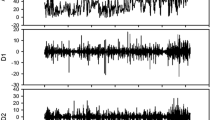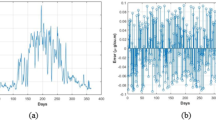Abstract
Emotional artificial neural network (EANN) a new generation of artificial neural network linked to the wavelet-based data preprocessing method, was used in this study to predict air pollution in Tabriz city, Iran, from 2015 to 2019. For comparison purposes, the classic feedforward neural network (FFNN) model was applied. Daily meteorological data, as well as pollutants concentration data, were used to predict air pollution concentration in the future. The results showed the efficiency of the EANN model in comparison with classic FFNN in predicting air pollution for Tabriz city. Also, the wavelet EANN (WEANN) model outperformed the wavelet FFNN (WFFNN) and EANN models by up to 4 and 14%, respectively. This result denotes the importance of preprocessing method than applying more updated artificial intelligence methods. The superiority of the proposed WEANN approach is in better learning of extraordinary and extreme values in the validation phase, due to the improved ability of EANN via hormones in comparison with ANN.












Similar content being viewed by others
Abbreviations
- EANN:
-
Emotional artificial neural network
- FFNN:
-
Feedforward neural network
- WEANN:
-
Wavelet EANN
- WFFNN:
-
Wavelet FFNN
- WHO:
-
World Health Organization
- AI:
-
Artificial intelligence
- ARIMA:
-
Auto-regressive integrated moving average
- RMSE:
-
Root mean square error
- DC:
-
Determination coefficient
References
Abraham A, Nath B (2000) Hybrid intelligent systems design: a review of a decade of research. IEEE transactions on systems, man & cybernetics (Part-C) August
Addison PS, Murray K, Watson J (2001) Wavelet transform analysis of open channel wake flows. J Eng Mech 127(1):58. https://doi.org/10.1061/(ASCE)0733-9399
Alimissis A, Philippopoulos K, Tzanis CG, Deligiorgi D (2018) Spatial estimation of urban air pollution with the use of artificial neural network models. Atmos Environ 191:205–213
Bai Y, Li Y, Wang X, Xie J, Li C (2016) Air pollutants concentrations forecasting using back propagation neural network based on wavelet decomposition with meteorological conditions. Atmos Pollut Res 7(3):557–566
Berenji HR, Khedkar P (1992) Learning and tuning fuzzy logic controllers through reinforcements. IEEE Trans Neural Netw 3(5):724–740
Cabaneros SM, Calautit JK, Hughes BR (2019) A review of artificial neural network models for ambient air pollution prediction. Environ Model Softw 119:285–304
Czogala E, Leski J (2000) Fuzzy and neuro-fuzzy intelligent systems. Physica-Verlag Springer, pp 65–92
Feng X, Li Q, Zhu Y, Hou J, Jin L, Wang J (2015) Artificial neural networks forecasting of PM2.5 pollution using air mass trajectory based geographic model and wavelet transformation. Atmos Environ 107:118–128
Ghorani-Azam A, Riahi-Zanjani B, Balali-Mood M (2016) Effects of air pollution on human health and practical measures for prevention in Iran. J Res Med Sci 21:65. https://doi.org/10.4103/1735-1995.189646
Guo Q, He Z, Li S, Li X, Meng J, Hou Z, Liu J, Chen Y (2020) Air pollution forecasting using artificial and wavelet neural networks with meteorological conditions. Aerosol Air Qual Res 20:1429–1439. https://doi.org/10.4209/aaqr.2020.03.0097
He J, Yu Y, Xie Y, Mao H, Wu L, Liu N, Zhao S (2016) Numerical model-based artificial neural network model and its application for quantifying impact factors of urban air quality. Water Air Soil Pollut 227(7):235
Hrust L, Klaić ZB, Križan J, Antonić O, Hercog P (2009) Neural network forecasting of air pollutants hourly concentrations using optimised temporal averages of meteorological variables and pollutant concentra-tions. Atmos Environ 43(35):5588–5596
Jeddi H, Abbaspour R, Khalesian M, Alawi Panah K (2017) Prediction of carbon monoxide concentration in Tehran metropolis using artificial neural net-works. Q J Environl Sci Technol 19:13–25 ((in Persian))
Khashman A (2008) A modified backpropagation learning algorithm with added emotional coefficients. IEEE Trans Neural Netw 19(11):1896–1909
Kurt A, Oktay AB (2010) Forecasting air pollutant indicator levels with geo-graphic models 3 days in advance using neural networks. Expert Syst Appl 37(12):7986–7992
Legates DR, McCabe GJ (1999) Evaluating the use of “goodness-of-fit” measures in hydrologic and hydroclimatic model validation. Water Resour Res 35(1):233–241. https://doi.org/10.1029/1998WR900018
Lei L, Chen W, Xue Y, Liu W (2019) A comprehensive evaluation method for indoor air quality of buildings based on rough sets and a wavelet neural network. Build Environ 162:106296
Liu H, Yin S, Chen C, Duan Z (2020) Data multi-scale decomposition strategies for air pollution forecasting: a comprehensive review. J Clean Prod 277:124023
Lotfi E, Akbarzadeh-T MR (2016) A winner-take-all approach to emotional neural networks with universal approximation property. Inf Sci 346:369–388
Nayak PC, Sudheer KP, Rangan DM, Ramasastri KS (2004) A neuro-fuzzy computing technique for modeling hydrological time series. J Hydrol 291(1–2):52–66
Nourani V (2017) An emotional ANN (EANN) approach to modeling rainfall-runoff process. J Hydrol 544:267–277
Nourani V, Hosseini Baghanam A, Adamowski J, Kisi O (2014) Applications of hybrid wavelet-artificial intelligence models in hydrology: a review. J Hydrol 514:358–377. https://doi.org/10.1016/j.jhydrol.2014.03.057
Nourani V, Molajou A, Uzelaltinbulat S, Sadikoglu F (2019) Emotional artificial neural networks (EANNs) for multi-step ahead prediction of monthly precipitation; case study: northern Cyprus. Theor Appl Climatol 138:1419–1434. https://doi.org/10.1007/s00704-019-02904-x
Roshni T, Jha MK, Drisya J (2020) Neural network modeling for groundwater-level forecasting in coastal aquifers. Neural Comput Applic 32:12737–12754
Schwartz J, Marcus A (1990) Mortality and air pollution j london: a time series analysis. Am J Epidemiol 131(1):185–194
Shekarrizfard M, Karimi-Jashni A, Hadad K (2012) Wavelet transform-based artificial neural networks (WT-ANN) in PM 10 pollution level estimation, based on circular variables. Environ Sci Pollut Res 19(1):256–268
Wang W, Ding J (2003) Wavelet network model and its application to the prediction of hydrology. Nat Sci 1(1):67–71
World Health Organization (2011) Database: outdoor air pollution in cities. Retrieved from http://www.who.int/phe/health_topics/outdoorair/databases/cities-2011/en/
Zhang C, Ding R, Xiao C, Xu Y, Cheng H, Zhu F, Lei R, Di D, Zhao Q, Cao J (2017) Association between air pollution and cardiovascular mortality in Hefei, China: a time-series analysis. Environ Pollut 229:790–797
Zhang J, Qiu H, Li X, Niu J, Nevers MB, Hu X, Phanikumar MS (2018) Real-Time nowcasting of microbiological water quality at recreational beaches: a wavelet and artificial neural network-based hybrid modeling approach. Environ Sci Technol 52(15):8446–8455
Zhu F, Ding R, Lei R, Cheng H, Liu J, Shen C, Zhang C, Xu Y, Xiao C, Li X, Zhang J (2019) The short-term effects of air pollution on respiratory diseases and lung cancer mortality in Hefei: a time-series analysis. Respir Med 146:57–65
Acknowledgment
The authors appreciate the meteorological and environmental organizations of East Azerbaijan province, Iran, for providing data for the current study.
Author information
Authors and Affiliations
Corresponding author
Ethics declarations
Conflict of interest
There is no conflict
Additional information
Editorial responsibility: I. Akkurt.
Rights and permissions
Springer Nature or its licensor (e.g. a society or other partner) holds exclusive rights to this article under a publishing agreement with the author(s) or other rightsholder(s); author self-archiving of the accepted manuscript version of this article is solely governed by the terms of such publishing agreement and applicable law.
About this article
Cite this article
Baghanam, A.H., Nourani, V. & Karimzadeh, H. Improving artificial intelligence-based air pollution modeling with the application of meteorological data. Int. J. Environ. Sci. Technol. 21, 431–446 (2024). https://doi.org/10.1007/s13762-023-05273-1
Received:
Revised:
Accepted:
Published:
Issue Date:
DOI: https://doi.org/10.1007/s13762-023-05273-1




